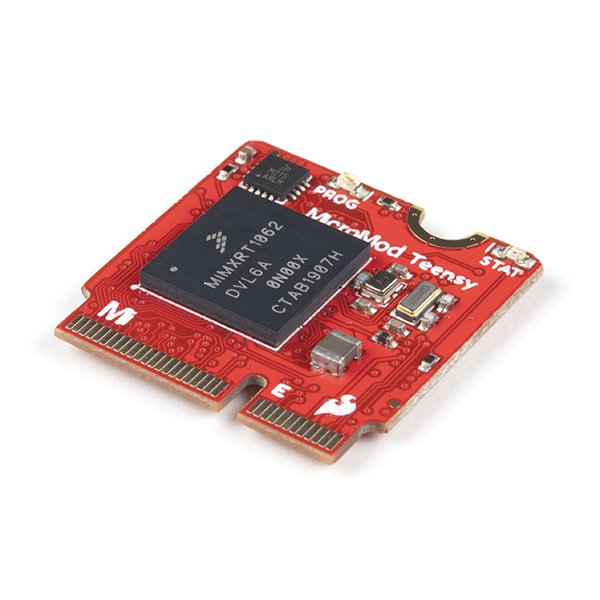With the recent announcement of shortages around the Teensy 3.2, 3.5 and 3.6, we expect many of you will begin upgrading your Teensy designs to the latest versions - Teensy 4.0, Teensy 4.1 or MicroMod Teensy.
At a high level, the layout of the Teensy 4.x is very similar to the version 3.x boards, while providing a superset of functionality. In addition, all of the Teensy 4.x versions are much more powerful than the 3.x versions, with faster processors (5 to 15 times faster!) and more memory. Luckily, both versions run on the same world renowned Teensy software, making firmware transition straightforward.
We would highly encourage anyone still using a Teensy 3.x board in their designs to consider upgrading to a Teensy 4.x version. Read on for a more detailed breakdown of the benefits, tech specs and pinouts of each board.
Transitioning from Teensy 3.x to Teensy 4.0 or 4.1
When it comes to transitioning from a Teensy 3.x board to the Teensy 4.0, Hackaday wrote a fantastic breakdown on the benefits of the 4.0 over 3.x boards, but specifically the 3.2, that’s definitely worth a read.
The path to transitioning to the 4.x version of Teensy often depends on the specific application the Teensy is being used in. Luckily, the awesome team at PJRC has resources to assist in any transition work.
For a full technical specification break down on each version of the Teensy boards, PJRC compiled this handy comparison chart.
From a pinout perspective, the simplest transition is going to be from the 3.2 to the 4.0, due to its pinout layout and similar size. However, none of the updated models should present much of a challenge. For reference, the pinout charts for each version can be found below:
Transitioning to SparkFun MicroMod Teensy
If you’re looking to add a bit more flexibility to your Teensy 3.x transition, the SparkFun MicroMod Teensy Processor Board is a great choice. The SparkFun MicroMod Teensy Processor Board is based on the Teensy 4.0 - supporting the same processor and capabilities in the Teensy software package and containing the same microprocessor. Delivered as a MicroMod processor board, the MicroMod Teensy opens up the "click and screw" rapid prototyping of MicroMod to the incredible power delivered by Teensy 4.0.
While a variety of MicroMod Carrier and Function boards are available within the MicroMod ecosystem, those looking to take full advantage of the Teensy Processor during their investigation and prototyping efforts should consider pairing it with the SparkFun MicroMod ATP Carrier Board, as many of the pins with extra functionality may be tied to a specific use on other Carrier Boards.
Additionally, the SparkFun MicroMod DIY Carrier Kit provides the basic M.2 connections and screws needed to build your own SparkFun MicroMod Carrier Board connection if you're feeling ambitious.
A pinout of both the processor and MicroMod Connector on the MicroMod Teensy Processor Board can be found in the pinout section of this page.
In Summary
Upgrading an existing product/solution is never an easy decision – required engineering work, changes in potential functionality and cost must all be evaluated. Luckily, with a migration to Teensy 4.x, hardware support information is readily available, and the common Teensy software makes the firmware transition straightforward. The end result being a modern, high-performance solution that easily meets today’s needs, as well as those of tomorrow.










Teensy 3.6 has a heavily DMA-controlled DAC, so it's still needed. I use it to generate sharply changing waveforms. This is a feat that cannot be done with an external SPI-connected DAC or PWM + external low-pass filter.
I've been looking for distribution stock all over the world, but I'm very tired. Thanks.
I would like a lockable version of the MicroMod. For certain commercial applications that can be important. I'm a little reluctant to move our product to MicroMod without knowing that lockable will be available at some point. I've shipped about a hundred commercial systems using the (locked) T3.6 so my quantities aren't huge. I like the platform in all other respects and would immediately buy a decent batch if it was lockable.
For my purposes, the Teensy 3.5 remains one of the best choices out there, primarily because it is 5V tolerant. This reduces parts count (no level shifting) and reduces the risk of blowing up the controller if I make an error in choosing or implementing a peripheral. It's way fast enough for just about everything I use a uC for... That said, I just bought some 4.1's-- excited about the ethernet jack and built-in pull-up and pull-down resistors. All in all, it's a very robust ecosystem.
Does the MicroMod processor board make the SWD debugging pins available? This has been physically disabled in all traditional teensy boards, but is fully supported by the processor. Having access to advanced debugging features would be a big plus for the MicroMod.
Looking at the schematic, it does not look like the SWD pins were broken out to the IMXRT..
Teensy 4.x is a great platform but not a replacement for 3.x in many projects because of power consumption, not to mention overkill. Lowering the clock speed to conserve power doesn't seem to be workable per PRJC forums.